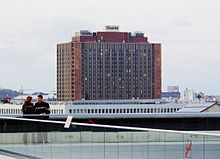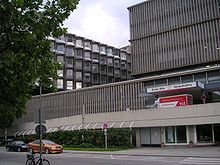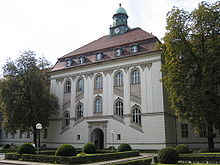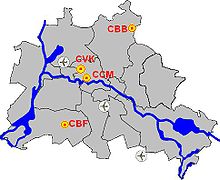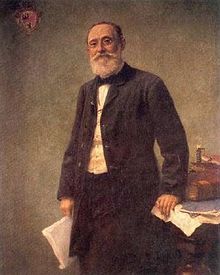- Charité
-

Established 1710 Type Public Rector Karl Max Einhäupl Admin. staff 10,400 (including hospital staff) Students 7,325 Location  Berlin, Germany
Berlin, GermanyCampus Urban Affiliations Free University of Berlin
Humboldt University of BerlinWebsite www.charite.de The Charité - Universitätsmedizin Berlin is the medical school for both the Humboldt University and the Free University of Berlin. After the merger with their fourth campus in 2003, the Charité is one of the largest university hospitals in Europe.[1]
Contents
History
Complying with an order of King Frederick I of Prussia from November 14, 1709, it was initially established in 1710 north of the Berlin city walls in anticipation of an outbreak of bubonic plague that already had depopulated East Prussia. After the plague spared the city it came to be used as a charity hospital for the poor. On January 9, 1727 Frederick William I of Prussia gave it the name Charité, meaning "charity".[2] The construction of an anatomical theatre in 1713 marks the beginning of the medical school, then supervised by the collegium medico-chirurgicum of the Prussian Academy of Sciences[3]. 1795 saw the establishment of the Pépinière school for the education of military surgeons.
After the University of Berlin (today Humboldt University) had been founded in 1810, the dean of the medical college Christoph Wilhelm Hufeland in 1828 integrated the Charité as a teaching hospital. Rudolf Virchow, once student at the Pépinière, worked with anatomist Robert Froriep as prosector here and in 1856 became director of the newly created institute of pathology, where he developed his cell theory.
After the partition of Berlin in 1949 the Charité in Mitte remained the main hospital of East Berlin affiliated with the Humboldt University, while the Free University of West Berlin had the Klinikum Steglitz erected in 1968 backed by the US Benjamin Franklin Foundation of Eleanor Lansing Dulles. In 1986 the town's Rudolf Virchow Hospital became the second medical school of the Free University. When after reunification the city of Berlin had to deal with three university hospitals, all were finally merged as sites of the Charité in 2003. The reorganization is still in progress.
Notable people
Many famous physicians and scientists worked or studied for at least part of their academic lives at the Charité. Among them were:
- Selmar Aschheim - gynecologist
- Heinrich Adolf von Bardeleben - surgeon
- Emil Adolf von Behring - physiologist (Nobel Prize in Physiology or Medicine in 1901)
- August Bier - surgeon
- Max Bielschowsky - neuropathologist
- Theodor Billroth - surgeon
- Ernst Boris Chain - biochemist (Nobel Prize in Physiology or Medicine in 1945)
- Hans Gerhard Creutzfeldt - neurologist and neuropathologist
- Johann Friedrich Dieffenbach - surgeon
- Paul Ehrlich - immunologist (Nobel Prize in Physiology or Medicine in 1908)
- Hermann Emil Fischer - chemist (Nobel Prize in Chemistry in 1902)
- Werner Forssmann - physician (Nobel Prize in Physiology or Medicine in 1956)
- Friedrich Theodor von Frerichs - pathologist
- Robert Froriep - anatomist
- Wilhelm Griesinger - psychiatrist and neurologist
- Hermann von Helmholtz - physician and physicist
- Friedrich Gustav Jakob Henle - physician, pathologist and anatomist
- Eduard Heinrich Henoch - pediatrician
- Otto Heubner - pediatrician
- Anton Ludwig Ernst Horn - psychiatrist
- Gero Hütter - hematologist
- Friedrich Jolly - neurologist and psychiatrist
- Robert Koch - physician (Nobel Prize in Physiology or Medicine in 1905)
- Albrecht Kossel - physician (Nobel Prize in Physiology or Medicine in 1910)
- Friedrich Kraus - internist
- Sir Hans Adolf Krebs - physician and biochemist (Nobel Prize in Physiology or Medicine in 1953)
- Bernhard von Langenbeck - surgeon
- Karl Leonhard - psychiatrist
- Hugo Karl Liepmann - neurologist and psychiatrist
- Fritz Albert Lipmann - biochemist (Nobel Prize in Physiology or Medicine in 1953)
- Leonor Michaelis - biochemist and physician
- Hermann Oppenheim - neurologist
- Samuel Mitja Rapoport - biochemist and physician
- Moritz Heinrich Romberg - neurologist
- Doreen Rosenstrauch - physician
- Ferdinand Sauerbruch - surgeon
- Curt Schimmelbusch - physician and pathologist
- Johann Lukas Schönlein - physician and pathologist
- Theodor Schwann - zoologist
- Hans Spemann - embryologist (Nobel Prize in Physiology or Medicine in 1935)
- Ludwig Traube - physician and pathologist
- Rudolf Virchow - physician and pathologist
- Carl Friedrich Otto Westphal - neurologist and psychiatrist
- Carl Wernicke - neurologist
- Otto Heinrich Warburg - physiologist (Nobel Prize in Physiology or Medicine in 1931)
- August von Wassermann - bacteriologist
- Caspar Friedrich Wolff - physiologist
- Bernhard Zondek - endocrinologist
The Charité today
Today, 7,500 students are enrolled at the Charité. It treats 1,080,000 outpatients and 128,000 inpatients in 3,500 beds annually.[4] 14,400 people are employed at its four locations in Berlin:
- Charité Campus Mitte (CCM) in Berlin-Mitte
- Campus Benjamin Franklin (CBF) in Berlin-Lichterfelde (former Klinikum Steglitz)
- Campus Virchow Klinikum (CVK) in Berlin-Wedding
- Campus Berlin Buch (CBB) in Berlin-Buch
Strictly speaking, the locations in Mitte, Lichterfelde and Wedding are independent medical centers, each providing patients with the full range of medical treatments available in modern medicine. However, affiliated with the Deutsche Forschungsgemeinschaft and the Helmholtz Association of German Research Centres, special research and therapy focuses exist, such as the German Cardiology Center Berlin (German: Deutsches Herzzentrum Berlin, DHZB) at the Campus Virchow Klinikum, the Center for Space Medicine at the Campus Benjamin Franklin, the German Rheumatology Research Center at the Campus Charité Mitte, and the Center for Molecular and Clinical Cardiology at the Campus Berlin Buch. The DHZB possesses the largest heart transplantation program in Germany and, after London and Paris, the third largest worldwide.
References
External links
Coordinates: 52°31′36″N 13°22′47″E / 52.52667°N 13.37972°E
Categories:- Buildings and structures in Berlin
- Education in Berlin
- Hospitals in Germany
- Universities in Berlin
- Healthcare in Berlin
- 1710 establishments
- Hospitals established in the 1710s
Wikimedia Foundation. 2010.

